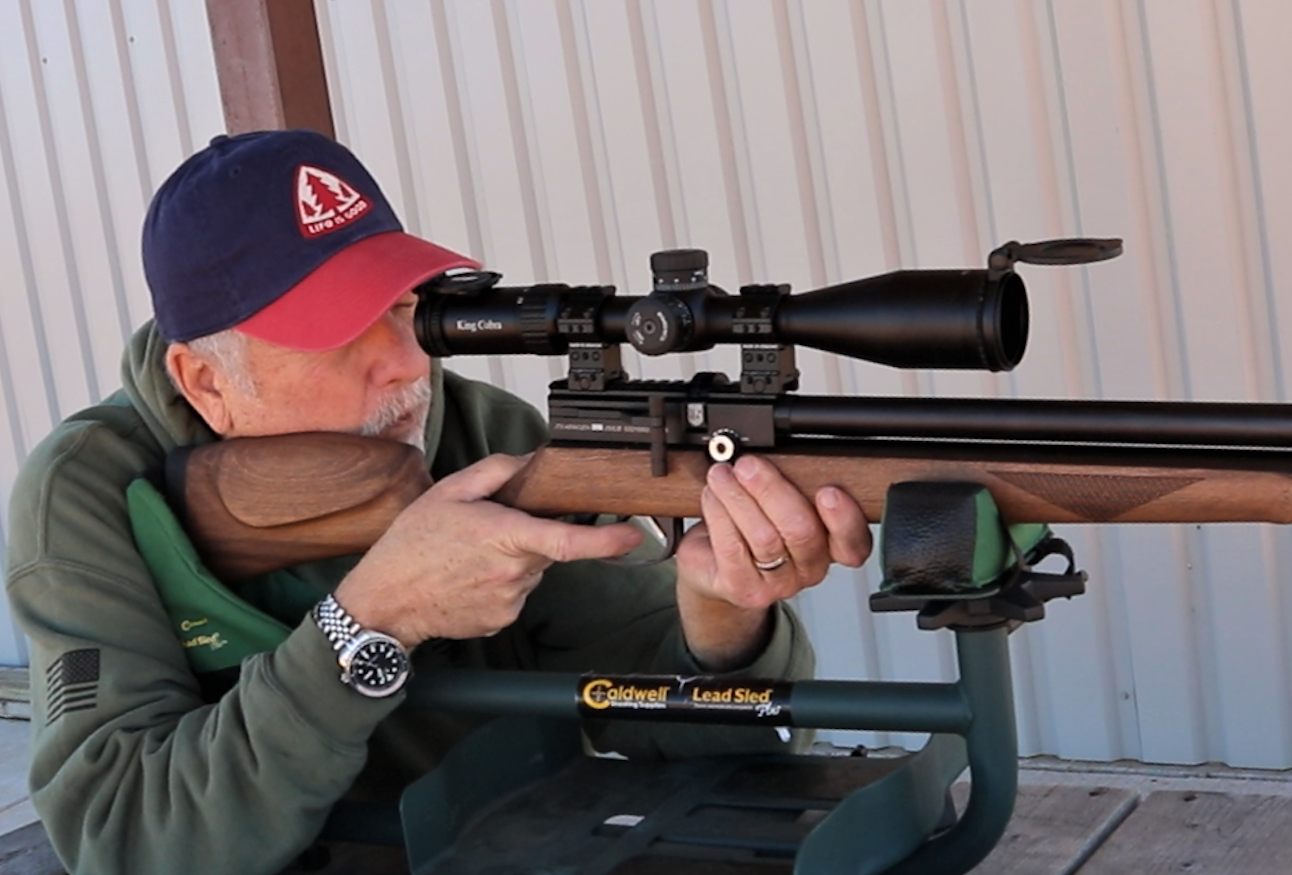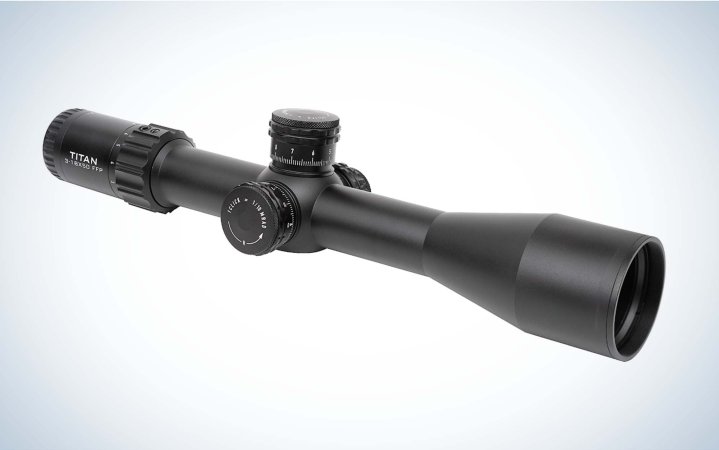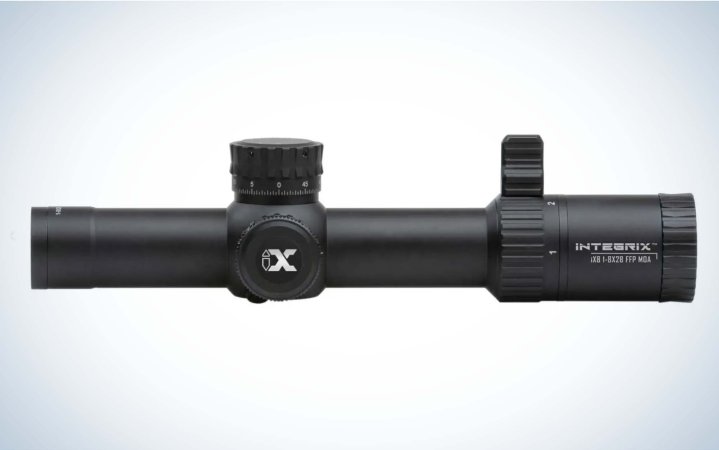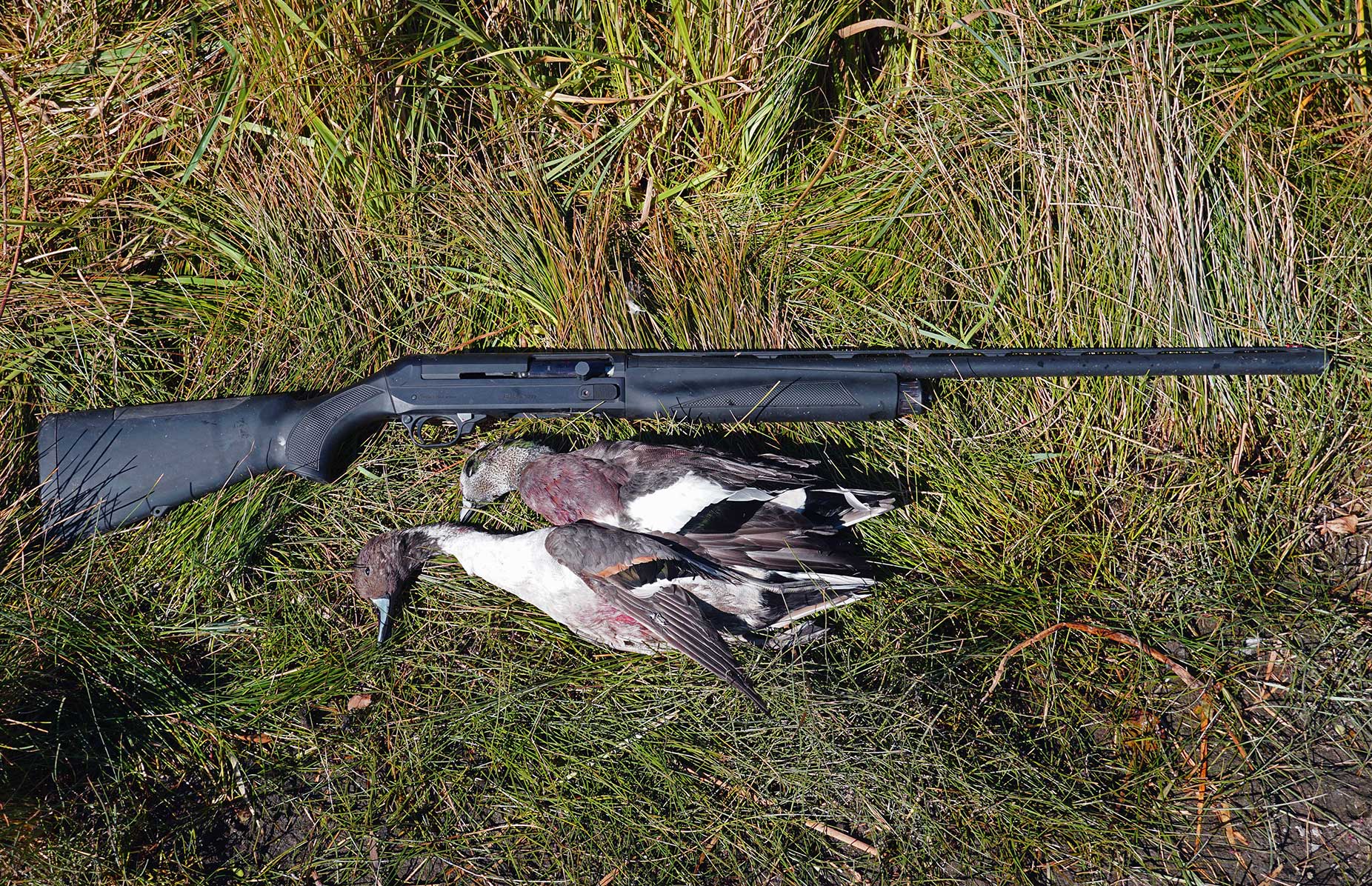Best Air Rifle Scopes of 2024

We may earn revenue from the products available on this page and participate in affiliate programs. Learn More ›
Today’s airguns shoot tiny groups at 50 yards and have a wide range of applications, calibers, and power plants. That’s why there’s not a single best air rifle scope. Instead, there’s a best scope for each of the different types of air rifles.
For example, spring-piston rifles can be notoriously tough on scopes, and require special scopes to handle their recoil impulse. Standard caliber pre-charged pneumatics can be laser accurate, but need quality optics to realize this potential. Regardless of whether it’s a .22 PCP rifle generating 30 ft-lb, a .72 caliber big bore generating 1300 ft-lb, or a traditional .177 springer topping out at 14 ft-lb—all will benefit from having a quality scope mounted. Here are my choices for the best air rifle scopes that fit the most types of rifle and applications.
Best Air Rifle Scopes: Reviews and Recommendations
Best for Precision Air Rifles: Vortex Viper HD 5-25×50 FFP
See It
Key Features
- First Focal Plane
- Reticle Options: VMR-4 MRAD (tested) or VMR-4 MOA
- 10 illumination settings
- Eye relief: 3.4 inches
- Field of view at 100 yards: 23.6 feet at 25 power and 4.7 feet at 5 power
- RevStop zerostop
- 30mm tube
- .1 MRAD or 1/4 MOA adjustments
- Max elevation: 18.9 MRAD or 68 MOA
- Travel per rotation: 10 MRAD or 25 MOA
- Parallax: 20 yards to infinity
- Weight: 25 ounces
- Free custom turret
- Price: $900
Pros
- Tactile elevation adjustment
- Great zero stop
- Good glass for the money
- Focuses at close range
Cons
- Windage adjustment is a little mushy
I tested the Viper HD 5-25 on my FX Impact M3, which is an air rifle that can shoot 1-inch groups at 100 yards, which is accuracy that rivals many of the best .22 rifles. I chose it as my test gun because the Viper HD 5-25 is an ideal scope for precision .22 rifles and airguns. The key feature that makes this a great rimfire scope is that the parallax adjusts from 20 yards to infinity with plenty of reference points for close range shooting. I did the bulk of my testing at 25 and 50 yards with zero issues getting a crisp image. The main issue with the parallax adjustment is that it sits right next to the knurled knob for switching on the illumination. Their proximity makes it possible to turn on the illumination when you want to adjust parallax.
Another feature that makes the Viper HD ideal for precision rimfire is its reticle. I shot a hundred pellets at a KYL rack at 25, 50, and 75 yards on a windy, prefrontal day. Whether I was holding elevation, wind, or both, the reticle gave me all the information I needed without feeling cluttered. I found the wind subtensions to be especially intuitive with small dots every .1 MIL and a bold dot every .5 MIL.
The zoom has enough tension that it won’t slip off a setting, but it’s still easy to make quick adjustments. The only thing that would make it better is adding a Switchview throw lever.
The locking elevation turret is a nice feature for preventing errant clicks. It unlocks by pulling the turret straight up, and the elevation adjustments are tactile and audible. Unfortunately the windage clicks weren’t as crisp on my test model.
I’ve used the RevStop zero stop on several Vortex scopes, including a Razor HD LHT that I took elk hunting. It’s a simple system that can be set in a few minutes. If you’re looking to push a rimfire to 300 yards, or beyond, you can remove the RevStop ring to get the most elevation out of the scope.

I’ve found the glass to be bright and clean from edge-to-edge. I could clearly make out detail on a 3D target 100 yards away 15 minutes past legal shooting light. I compared it to my Athlon Ares ETR and it held on a few minutes longer into the fading light. The Ares uses a 34mm tube and a larger objective, which makes that tight race impressive for the Viper HD.
The Viper HD 5-25×50 is about 6 ounces lighter than the Viper PST 5-25. If you add in the fact that it has a locking elevation turret and a capped windage turret, you have an excellent open-country hunting scope. —Scott Einsmann, gear editor
Best Long-Range: MTC King Cobra 6-24X50 F1
See It
Key Features
- Magnification: 6 to 24X
- Weight: 1.64 pounds
- Length: 14.4 inches
- 30mm tube
- Objective lens diameter: 50mm
- First focal plane reticle
- Etched reticle
- Side parallax adjustment
- Close focusing to 15 yards
Pros
- Good glass
- The Small Caliber Ballistic reticle is easy to use
- Good turrets
- Parallax correction from 15 yards to infinity
Cons
- Fairly expensive
- Some shooters prefer a second focal plane scope
This is another one of my go-to scopes; the King Cobra is an almost perfect optic for long-range shooting when mounted on a .25 or .30 caliber PCP rifle. The bold and easy-to-see reticle offers the right balance of multiple aiming points while remaining clear and uncluttered. I especially like this scope for long-range shooting applications, such as prairie dogs out to 150 yards, because it allows for precise shot placement.
The King Cobra is an ergonomic and well-proportioned scope that provides click-stop adjustments actuated by locking, finger-adjustable turrets. The scope utilizes MTC’s SCB2 multi-aimpoint reticle, providing numerous aiming points without being cluttered. The central crosshair can be illuminated to optimize shot placement in the low-light scenarios encountered when hunting at dawn and dusk. To maximize light transmission and maintain a bright sight picture, the King Cobra’s 30mm tube has been matched to a 50mm objective lens that’s been specially coated.
Most Versatile: Element Titan 3-18×50 FFP

See It
Key Features
- Magnification: 3-18x
- Tube Diameter: 34mm
- Objective Lens Diameter: 50mm
- Eye Relief: 4 inches
- Parallax: 10 yards to infinity
- Length: 14.57 inches
- Weight: 34.4 ounces
Pros
- Excellent low light capability
- Good reticle
- Parallax is well-suited to air rifles
Cons
I used my FX Impact M3 for small game hunting and shooting tiny groups at 50 to 100 yards. My optic of choice for both those applications is the Element Titan 3-18×50 FFP. It has the light gathering and wide field of view I need for shooting squirrels and the high-end magnification for printing small groups at 100 yards. A great feature for hunting or shooting steel targets, is the bright, crisp illumination of the entire reticle. The glass and magnification allow me to spot my own hits. The turrets have positive and precise clicks with plenty of adjustment range for reaching out well beyond 100 yards. The zero stop is very easy to set and is a must-have feature for dialing elevation.
The Element Titan is a great all-around scope that will excel in anything that requires excellent glass, turret tracking, low-light performance, and a great reticle. -S.E.
See It
Key Features
- Magnification range: 6 to 24X
- Length: 14.25 inches
- Weight: 26 ounces
- 30mm tube
- Objective lens diameter: 50mm
- Second focal plane
- MOA reticle
- Field of view at 100 yards: 19 to 4 feet
- Parallax adjustment: 10 yards to infinity
- Toolless turrets
- Removable throw lever
Pros
- Light and compact
- Excellent reticle configuration for hunting
- Excellent image quality
Cons
- Some shooters prefer FFP
- Competitive shooter may want a different reticle
- Magnification is too high for some applications
I’ve found this scope rugged and stable, and mine has stood up to rough use and never drifted from zero once locked down. I really like Element Optics Helix’s uncluttered MOA reticle for my all-around hunting rifles. The ability to correct for parallax down to 10 is an asset for a gun that you might shoot in your basement range one day, and at a groundhog 100 yards away the next.
The Helix from Element Optics is popular with hunters and competitors who want a high-quality scope at a moderate price point. Featuring tool-free stainless steel turret housings and a true zero stop, the turrets provide precision and consistency when adjusting the scope. The second focal plane (SFP), EHR-1C reticle is calibrated at 24 power, allows accurate holdover adjustment for both 12x and 6x magnifications, and is designed to estimate holdover when shooting in the field. Three distinct markings along the windage and elevation lines let the shooter find their holdover quickly without confusion.
The reticle is intuitive and uncluttered which I find useful when you need to line up and make your shot quickly and accurately. And while not inexpensive, the value delivered by this scope is very good. The Helix gives me everything I need in a hunting scope and it does those things well. It has outstanding image quality, excellent sighting through a clean utilitarian reticle, responsive adjustment controls, and overall ruggedness put this one at the top of my list.
See It
Key Features
- Magnification range: 3 to 9X
- Length: 12 inches
- Weight: 18.3 ounces
- 40mm objective lens (adjustable objective)
- 1-inch tube
- 1/4 MOA adjustments
- 7.5 yds to infinity parallax adjustment
- Spring piston airgun rated
Pros:
- Rugged, spring-piston rated
- Compact
- Great reticle for a hunting gun
- Attractive pricing
Cons
- Not enough elevation adjustment to shoot extended ranges
The Airmax Sport Optics line is practical, no-nonsense scopes that provide good optical performance at a budget price. The low light capabilities of this scope are good, and the AMX reticle offers adequate aim points while remaining uncluttered. The Airmax scopes are robust and stand up to use on powerful spring piston rifles. They are lightweight and compact, representing a great solution for small game hunting in the woodlands. I especially like this scope when paired with a compact rifle, as it provides an easily transportable rig.
Perhaps not as well known in the USA, Hawke Sport Optics has earned a reputation as being one of the best producers of airgun scopes. The glass on the Airmax line is of a solid quality, offering clarity and light transmission that punches above its price point. The Airmax 4-12×40 AO scope delivers a significantly wider field of view than standard riflescopes at a comparable price. The AMX reticle used on the Airmax scope is easily calibrated to work with airgun trajectories, including high-powered springers. This Reticle provides multiple aim points based on mil spacing; additional half-mil spacing provides holdover aim points.
Read Next: Best Pellet Guns: Budget Friendly Pellet Guns for Target Shooting and Hunting
Best Big Bore Scope: Leapers Integrix 1x8X28 34mm FFP Scope

See It
Key Features
- First Focal Plane
- 1-8x Magnification
- Multi-coated lenses
- Oversized lockable and zero resettable turrets
- Etched glass range estimating reticle
- 34 mm tube
Pros
- Excellent optical performance
- Excellent tactile responsiveness of controls
- Superior low-light performance
- An intuitive and fast sighting reticle
Cons
- Limited higher magnification for some applications
- Limited number of mounting options available (no 11mm mounts)
The Integrix scope has been mounted on several of the big-bore air rifles I’ve hunted over the last several months and has impressed me with its performance. First off, the scope is ergonomic and compact, has excellent user controls, and provides the perfect magnification range for big game at the 50–100-yard range. Of course, this would be meaningless if the optical quality wasn’t there, but the clarity, low light performance, and wide field of view this scope offers make it my favorite choice for magnum big bores.
The Integrix scope is built on a 34mm tube, offering a high degree of adjustability. It is compact and provides a very good fit on a wide selection of big-bore guns, from compact carbines to longer barrel rifles. The windage and elevation controls are easy to work with while wearing gloves, and the throw lever for the magnification is the smoothest I’ve ever used.
Best High Magnification Hunting Scope: Vortex Razor HD LHT 4.5-22×50
See It
Key Features
- Magnification: 4.5 to 22 power
- Field of view at 100 yards: 23.5 to 4.7 feet
- Adjustments: .25 MOA
- Weight: 21.7 ounces
- First-plane precision reticle
- Locking exposed elevation turret, capped windage turret
- Push-button illumination control
- 25-yard-to-infinity parallax
Pros
- Ability to focus as close as 25 yards makes this a decent rimfire scope
- XLR-2 MOA-based reticle is useful without being cluttered
- Push-button illumination is smart and both bright and subdued
Cons
- The elevation turret turns a little too easily
- Like to see a MRAD version of this reticle
Vortex has done a nice job of offering a hunting scope that will feel like a precision tactical scope for long-distance target shooters, and like a precision target scope for long-range hunters. It’s the ultimate crossover scope, with a first-plane reticle tuned to MOA references, a low-profile locking elevation turret that’s easy to dial, along with a capped windage turret, and a rock-solid turret zero stop. By combining features from hunting and long-range precision shooting, the Razor HD LHT is precise without being ponderously heavy and big.
At 21.7 ounces, the 30mm scope is not a featherweight, but would be right at home on a lightweight hunting rifle. And it keeps its trim figure by combining the illumination module inside the parallax dial. Inside, the Razor HD LHT features 75 MOA of total elevation adjustment and 45 MOA of windage adjustment. The glass is bright, coatings make the image pop, and it has great durability along with Vortex’s legendary lifetime transferrable warranty. – Andrew McKean, optics editor
Read our full review of the Razor HD LHT to learn more.
Read Next: Most Powerful Air Rifles
See It
Key Features
- Magnification: 3 to 9X
- Length: 12.7 inches
- Weight: 17 ounces
- 1-inch tube
- 40mm objective lens with adjustable objective
- 1/4 MOA adjustments
- Fast focus eyepiece and easily-adjustable zoom ring
- Adjustable objective for parallax from 10 yards to infinity
- 100 MOA of elevation and windage adjustment
- Aluminum construction
Pros
- Performs above its price point
- Clear image
- Good low light performance
- Good reticle
- Light and streamlined design
Cons
- The optical quality is good, but not great
- The parallax focus is fixed
- 1-inch tube limits elevation
- Not rated for spring-piston airguns (PCP only)
The Vantage line is Hawke’s budget-friendly offering, which consists of an extensive range of scopes to suit all calibers and disciplines, both firearms and airguns. All Vantage riflescopes feature Hawkes H2 optics in a variety of configurations. There are both 1 inch and 30 mm tube versions, and more recently, FFP models have been added.
The Vantage 3-9×40 model I chose as my best budget pick is built on a 1-inch tube and is a second focal plane scope. I’ve found the capped turrets responsive, easy to adjust, and hold zero after a season’s use.
At around $150, there are less expensive scopes on the market, but in my opinion, they don’t offer the performance or features to match the Hawke Vantage. This scope is one of those rare instances in the optics world where the performance is better than the price tag would suggest. This is a low-cost scope that will work well for you over the long haul, and I don’t think you’ll find better glass for the money.
How to Choose the Best Air Rifle Scope for You
As with most gear, when you get ready to scope your air rifle, ask yourself how you’ll use it and which gun you’ll mount it on. Those answers provide a good start on determining the must-have features and specifications.
As an example, when looking for a scope for my squirrel and rabbit hunting rig where I generally keep shots inside of 50 yards and use magnification in the 6 to 8x range. For that scope, high magnification isn’t a priority for me. However, on the gun I use for shooting prairie dogs out to 125 yards, there is a requirement for high magnification that allows me to see a prairie dog’s very small kill zone. In either case, optical quality, a usable reticle, tactile and responsive turrets, and good low light transmission are always high priorities for me. I like an illuminated reticle, but can live without it. There are other considerations such as the dimensions of the scope, the weight, and adjustment features.
I’d suggest that you pay attention to certain features, such as whether a first focal plane or a second focal plane suits you better. Don’t get caught up in the hype and the online debates about which is better. Take the time to understand the pros and cons of each, and then again weigh those against your projected use case.
After you decide on the important features, you need to work out the budget. I typically budget around $300-800 when buying a quality scope as a general rule. That price range is the sweet spot for good glass, features, and durability. You can spend a lot more, but I don’t think that’s necessary for most people. And if you are budget constrained, be aware that some decent lower priced optics are available in the $100-200 price.
Read Next: The Best PCP Air Rifle Compressors
FAQs
There are two primary differences between riflescopes and scopes made for air rifles. The first applies to scopes on spring-piston guns, which require scopes with a spring-piston rating because the bi-directional recoil created by springers can even destroy a scope designed for a magnum centerfires. This is not a problem for PCP rifles which are generally very low recoil, except for big bores, and generate a recoil impulse more like a firearm.
The second difference is the parallax correction which must either be set closer for an airgun than a standard firearm scope or be adjustable. This is because airguns are often used from 5 to 100 yards, whereas a typical rifle scope might have parallax correction down to 50 yards.
Many airgunners prefer higher magnifications because even though they tend to shoot at closer ranges, the targets they shoot are generally much smaller. Precise shot placement is the name of the game with airguns, and a heart or brain shot on a prairie dog at 100 yards is a very small target. High magnification, like 24X, helps with that precision.
Final Thoughts on the Best Air Rifle Scopes
Whether you’re kitting out a backyard plinker or a heavy-hitting big bore air rifle, your air rifle deserves a quality scope, and I’ve made that easy for you with my picks for the best air rifle scopes. As a final tip, make sure you invest in quality mounts for your new scope and take the time to torque the scope mounts properly.
Read the full article here







